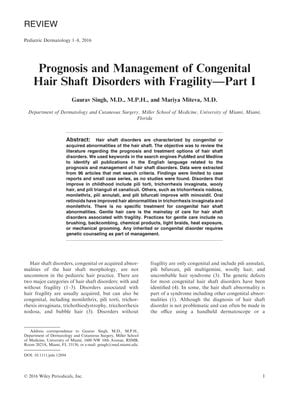Prognosis and Management of Congenital Hair Shaft Disorders with Fragility—Part I
June 2016
in “
Pediatric Dermatology
”
pili torti trichorrhexis invaginata wooly hair pili trianguli et canaliculi trichorrhexis nodosa monilethrix pili annulati pili bifurcati minoxidil oral retinoids gentle hair care genetic counseling Netherton syndrome SPINK5 mutation trichothiodystrophy DNA repair gene mutations brittle hair prenatal diagnosis Rogaine

TLDR Some congenital hair disorders improve in childhood or with treatments like minoxidil and retinoids, while others like Netherton syndrome and trichothiodystrophy have a poor prognosis.
In the 2016 review by Singh and Miteva, congenital hair shaft disorders with fragility were examined, with data extracted from 96 articles. Disorders such as pili torti, trichorrhexis invaginata, wooly hair, and pili trianguli et canaliculi often improve during childhood, while trichorrhexis nodosa, monilethrix, pili annulati, and pili bifurcati showed improvement with minoxidil. Oral retinoids helped with trichorrhexis invaginata and monilethrix. Gentle hair care is the main management strategy, and genetic counseling is recommended. Netherton syndrome, associated with a SPINK5 mutation, has a poor prognosis with high infant mortality, and various treatments have shown mixed results without monitored hair improvements. Trichothiodystrophy, linked to DNA repair gene mutations, presents with brittle hair and poor prognosis, with management options being limited and prenatal diagnosis available for those with photosensitivity.






